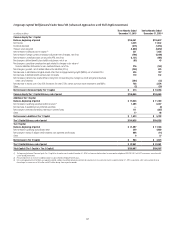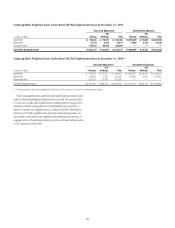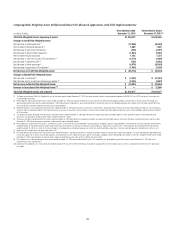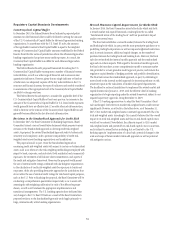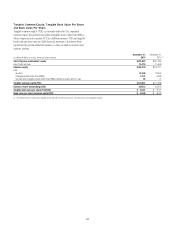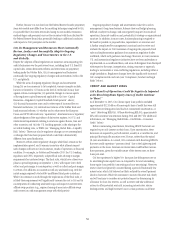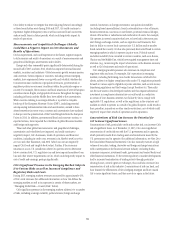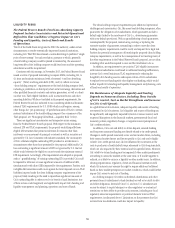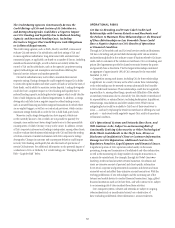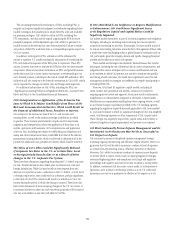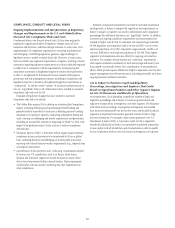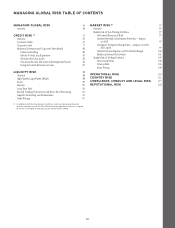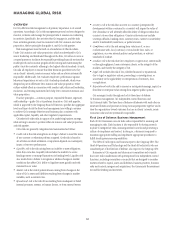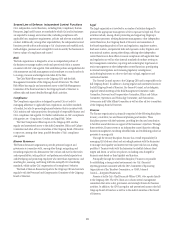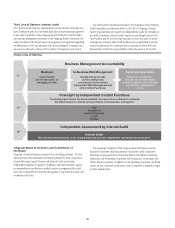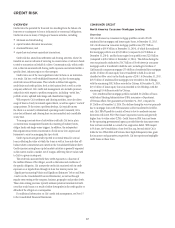Citibank 2015 Annual Report Download - page 75
Download and view the complete annual report
Please find page 75 of the 2015 Citibank annual report below. You can navigate through the pages in the report by either clicking on the pages listed below, or by using the keyword search tool below to find specific information within the annual report.57
The Credit Rating Agencies Continuously Review the
Credit Ratings of Citi and Certain of Its Subsidiaries,
and Ratings Downgrades Could Have a Negative Impact
on Citi’s Funding and Liquidity Due to Reduced Funding
Capacity and Increased Funding Costs, Including
Derivatives Triggers That Could Require Cash Obligations
or Collateral Requirements.
The credit rating agencies, such as Fitch, Moody’s and S&P, continuously
evaluate Citi and certain of its subsidiaries, and their ratings of Citi and
its more significant subsidiaries’ long-term/senior debt and short-term/
commercial paper, as applicable, are based on a number of factors, including
standalone financial strength, as well as factors not entirely within the
control of Citi and its subsidiaries, such as the agencies’ proprietary rating
agency methodologies and assumptions and conditions affecting the
financial services industry and markets generally.
Citi and its subsidiaries may not be able to maintain their current
respective ratings. Ratings downgrades could negatively impact Citi’s ability
to access the capital markets and other sources of funds as well as the costs of
those funds, and its ability to maintain certain deposits. A ratings downgrade
could also have a negative impact on Citi’s funding and liquidity due to
reduced funding capacity, including derivative triggers, which could take the
form of cash obligations and collateral requirements. In addition, a ratings
downgrade could also have a negative impact on other funding sources,
such as secured financing and other margined transactions for which there
are no explicit triggers, as well as on contractual provisions, which contain
minimum ratings thresholds in order for Citi to hold third-party funds.
Moreover, credit ratings downgrades can have impacts, which may
not be currently known to Citi or which are not possible to quantify. For
example, some entities may have ratings limitations as to their permissible
counterparties, of which Citi may or may not be aware. In addition, certain
of Citi’s corporate customers and trading counterparties, among other clients,
could re-evaluate their business relationships with Citi and limit the trading
of certain contracts or market instruments with Citi in response to ratings
downgrades. Changes in customer and counterparty behavior could impact
not only Citi’s funding and liquidity but also the results of operations of
certain Citi businesses. For additional information on the potential impact of
a reduction in Citi’s or Citibank, N.A.’s credit ratings, see “Managing Global
Risk—Liquidity Risk” below.
OPERATIONAL RISKS
Citi Has Co-Branding and Private Label Credit Card
Relationships with Various Retailers and Merchants and
the Failure to Maintain These Relationships or the Renewal
of These Relationships on Less Favorable Terms Could
Have a Negative Impact on Citi’s Results of Operations
or Financial Condition.
Through its Citi-branded cards and Citi retail services credit card businesses,
Citi has co-branding and private label relationships with various retailers
and merchants globally in the ordinary course of business whereby Citi issues
credit cards to customers of the retailers or merchants. Citi’s co-branding and
private label agreements provide for shared economics between the parties
and generally have a fixed term. The five largest relationships constituted
an aggregate of approximately 10% of Citi’s revenues for the year ended
December 31, 2015.
Competition among card issuers, including Citi, for these relationships
is significant. As a result, Citi may not be able to renew these relationships,
or the relationships may be renewed on terms substantially less favorable
to Citi’s credit card businesses. These relationships could also be negatively
impacted due to, among other things, operational difficulties of the retailer
or merchant, termination due to a breach by Citi, the retailer or merchant of
its responsibilities, or external factors, including bankruptcies, liquidations,
restructurings, consolidations and other similar events. While various
mitigating factors could be available to Citi if any of these events were to
occur — such as by replacing the retailer or merchant or offering new card
products — such events could negatively impact Citi’s results of operations
or financial condition.
Citi’s Operational Systems and Networks Have Been, and
Will Continue to Be, Subject to an Increasing Risk of
Continually Evolving Cybersecurity or Other Technological
Risks Which Could Result in the Theft, Loss, Misuse or
Disclosure of Confidential Client or Customer Information,
Damage to Citi’s Reputation, Additional Costs to Citi,
Regulatory Penalties, Legal Exposure and Financial Losses.
A significant portion of Citi’s operations relies heavily on the secure
processing, storage and transmission of confidential and other information
as well as the monitoring of a large number of complex transactions on
a minute-by-minute basis. For example, through its Global Consumer
Banking, credit card and securities services businesses, Citi obtains and
stores an extensive amount of personal and client-specific information
for its retail, corporate and governmental customers and clients and must
accurately record and reflect their extensive account transactions. With the
evolving proliferation of new technologies and the increasing use of the
Internet and mobile devices to conduct financial transactions, large, global
financial institutions such as Citi have been, and will continue to be, subject
to an increasing risk of cyber incidents from these activities.
Citi’s computer systems, software and networks are subject to ongoing
cyber incidents such as unauthorized access; loss or destruction of
data (including confidential client information); account takeovers;


